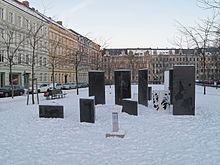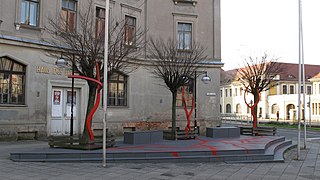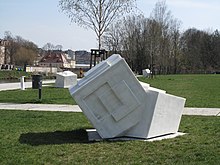Görlitzer ART
Görlitzer Art was a temporary art exhibition organized by the city of Görlitz in cooperation with the city of Breslau (Wrocław) . The art project showed sculptures in public spaces and was part of the “ European Capital of Culture Wrocław 2016”. Görlitzer Art was curated by the Eugeniusz Geppert Academy of Fine Arts in Wrocław and coordinated by the Görlitzer Kulturservicegesellschaft mbH. The presentation took place from April 1, 2016 to April 9, 2017 in public places in Görlitz. Some works can still be seen in the cityscape in 2020.
Modalities
The exhibition of the artistic designs for the German-Polish project had been on view since June 23, 2015 in the Johannes-Wüsten-Saal of the baroque house Neißstraße 30 in Görlitz, at the opening of which the eight artists from Poland were also present, who created the works of art for the designed the public space of the city of Görlitz. Three of the ten works were selected in an open vote from 24 offers from the Wroclaw art students, which were presented from January 7 to 20, 2016 in the Galerie Brüderstraße. Most of the votes were received for the Cloud Swing , Puls der Stadt and Uhr . Six were selected in the competition process. The salt crystals object in the Uferpark was determined to be the project to be carried out.
The art project should "offer locals and visitors a new view of our city for a year," said Mayor Siegfried Deinege , who officially opened it together with Adam Grehl, Vice President of Wrocław, on April 1st at 2:00 p.m. on Wilhelmsplatz in Görlitz opened.
Art in public space was first to be experienced in Görlitz in this stylistic and thematic variety. For the outdoor exhibition, artists from Wroclaw designed and implemented their ideas specifically for specific locations in Görlitz. They are both established artists whose art is already represented in many countries around the world, as well as students of the Wrocław Art Academy. For the first time, they got the chance to design public space, especially abroad. An installation was contributed by the Saxon artist Matthias Lehmann .
When the exhibition opened on April 1, 2016, some of the works had not yet been completed (the mask ) or had not yet been erected ( spindle , cloud swing , pulse of the city ). They emerged in the following weeks.
vandalism
As early as May 2016, a discussion about vandalism on the works of art broke out in the city. With a few exceptions, these were again and again the target of destruction. Some of the works had to be repaired several times. The cloud swing was also not constructed robust enough. Finally, several works were prematurely removed from the cityscape.
Works of art
&

The light installation & by Krzysztof Furtas was on Wilhelmsplatz . In the form of the & symbol , it referred to the border situation and coexistence of the twin cities Görlitz and Zgorzelec , which form a European city . The work symbolizes neighborhood, community and cooperation and symbolically stands for a connection, relationship and here in particular for the growing together of Poland and Germany. By reducing it to the essentials and at the same time generally understandable, the succinct form acts like the essence of communication.
The project was funded by the two cities; other supporters were the Sparkasse Oberlausitz-Lower Silesia Foundation, the Cultural Foundation of the Free State of Saxony , the Federal Commissioner for Culture and Media , the Saxon State Chancellery , the Upper Lusatia-Lower Silesia cultural area , KommWohnen GmbH and the Görlitz municipal utility AG.
tower

The Tower of Tomasz Domański was on the Hotherstraße before Vierradenmuhle . It fitted into the series of towers, bastions and church bell towers that survived the turmoil of World War II and that determine the architectural fabric of the city. With its contemporary, sculptural-architectural form, it represented a link between the historical building heritage and today's city.
The property with its interaction sfördernden open form should cultural and social discourses promote the city. This enabled the residents to participate more intensively in the design of their immediate surroundings.
The viewer could enter the sculpture and experience its interior, i.e. perceive it multidimensionally and was not limited to visual aspects. If the viewer looked up inside the tower, he saw a gradually narrowing vault, whose superimposed circles and refractions of light are supposed to convey the feeling of dealing with almost organic matter. Inside the sculpture, the visitor should feel surrounded by calm and isolated from the world. This state stimulates contemplation , whereby the object fits into the architectural context of the city's sacred buildings.
herd
The three-part room installation by Piotr Wesołowski was inspired by terms such as movement, community and family. It is a metaphor for a wandering herd looking for a place to rest. Therefore, the object moved several times during the exhibition. The herd grazed from April 1, 2016 on Elisabethplatz, from September 1, 2016 on Marienplatz and from December 1, 2016 on the Theaterwiese. The change of location was made possible by the light material and uncomplicated assembly on the ground. Despite the size of the object, the perforated metal plates gave the entire installation a sense of mobility and lightness. The interaction was guaranteed by the accessibility. Colored lighting made the installation an eye-catcher even at night.
mask
The mask of Marianne Wesołowska-Eggimann on the middle of the roundabout Bahnhof- / Salomon Street raised a versatile range of topics. A white sculpture in public space is almost a provocation. She literally invited rioters and graffiti artists to leave their mark. Likewise, in its purity and vulnerability, it was exposed in a very direct way to the dirt of the city and environmental influences. This provocation was part of the work and made people aware of the challenges, the attacks and the struggles that we as humans are exposed to in our modern life.
spindle
This colored work of art by Marianne Wesołowska-Eggimann (* 1980), Karolina Kiełpińska (* 1993), Anna Rottau (* 1993) was painted in mid-April 2016 on the street and the adjacent path at Görlitz Lutherplatz . The seamless painting of the street and the footpath with three-dimensional layers of paint created a new environment, the aim of which was to relive the space known from everyday life through a "total" artistic intervention. Depending on the viewer's position, the street took on a different shape. The “human eye was manipulated, magnetized and curiosity aroused” by breaking perspectives and creating colors.
border

The walk-in composition by Tomasz Tomaszewski , which is located in the middle of Lutherplatz , consists of 14 prisms between 60 and 225 cm high, which are placed differently on an area of 10 × 7 meters. The large prisms were mirrored on one side, so that they created a mirror wall, which gave the name of the work. The viewer should almost observe how the border dissolves into infinity. The work was a place of diffusion and exchange. The social space not only contains interactive potential, but also invites you to think about the local context and limits in general with regard to yourself.
Cloud swing
This student work received by far the most votes during the public vote. The name of this interactive installation by Paulina Sobczyk , Madgalena Pietrasik , Klaudia Kaczmarek already reveals the lightness of the clouds as a source of inspiration. It was installed on Otto-Buchwitz-Platz. Many loops of fabric hanging from trees gave the impression of a cloud from a distance. Far-hanging loops invited people to sit down, swing and linger. However, the cloud swing was not built robust enough for this, so that it had to be repaired several times and was finally dismantled prematurely.
Pulse of the city
The pulse of the city by Karolina Woch , Karolina Koryniowska and Agata Kapiczyńska was implemented by students from Wroclaw on the upper Berliner Straße. This work was voted 2nd in the public vote by the people of Görlitz. Sculpture ale, monochrome forms grew from the ground (on Tartan ) up to the trees. With the location opposite the Görlitz train station , the installation not only offered a colorful reception for the visitors, but also led them to the once pulsating shopping street with a direct route to the city center. The two-part work was intended to liven up the otherwise dreary upper part of Berliner Straße with color and invite you to linger, rest or wait.

Clock
The clock by Anna Kuśmierczyk and Klaudia Heintze , installed on the facade of the former Plant I of Waggonbau Görlitz in today's Conrad-Schiedt-Straße, took 3rd place in the public vote on the student designs. Due to its size, it was visible from afar and thus became an optical fixed point. The association of the four main windows of the former factory building with a clock now gave Werk I its second chance and more attention. In addition to a friendly welcome, the plant offered the adjacent bus station a practical aid.
Salt crystals
The installation salt crystals by Matthias Lehmann has been in the Uferpark since March 11, 2016. The artist himself commented on the motivation: “The motivation for the sculptural work lies in the decisive role of salt, which was one of the first commercial goods to be an essential motor for the development of trade routes, including the Via regia running through Görlitz . As a result, many trading centers and cities emerged along these routes, the expansion of which not only transported goods but also ideas. Cities whose distances previously seemed insurmountable were moving closer together. The people began to bring new ideas and developments from place to place and thus to promote mutual understanding and unity among the peoples. "
“Another motivation for this installation is the fascination with the formal appearance, which arises when salt crystals slowly grow under certain circumstances and develop their crystalline, cubic structures. The design provides for the enlargement of several salt crystals, which are to be set up in the form of three individual sculptures on the lawn of the Uferpark on the Neisse. In addition to their formal beauty, these should also recall the beginnings of our social development and at this particular location, the Via regia crossing the Neisse, draw attention to the importance of the first commercial efforts. "
“Furthermore, salt, as an essential means for the production of synthetic dyes from the 19th century, will be used to establish a connection to the newly designed area of the Uferpark, which refers to the tradition of a textile factory located at this location. This constant change from the first beginnings of a river crossing through industrialization to today is also addressed with the salt crystals. "
Web links
- Art in the public space of the city of Görlitz • Sztuka w przestrzeni publicznej miasta Görlitz. ( Memento from June 11, 2016 in the Internet Archive ). In: Görlitzer ART , 2016
- Presentation of the artists. ( Memento from June 2, 2016 in the Internet Archive ). In: Görlitzer ART , 2016
Individual evidence
- ↑ a b Exhibition with models for “Görlitzer ART” opens. In: City of Görlitz. June 22, 2015, accessed August 12, 2017 .
- ↑ a b tok / pm: The city as a gallery. In: Wochenkurier. January 4, 2016, accessed August 12, 2017 .
- ↑ Press release: City becomes gallery. ( Memento from April 4, 2016 in the Internet Archive ). In: Görlitzer ART , January 22, 2016, (PDF; 1.1 MB).
- ↑ Press release: Görlitz celebrates contemporary art. ( Memento from April 4, 2016 in the Internet Archive ). In: Görlitzer ART , March 31, 2016, (PDF; 496 kB).
- ↑ Wulf Stibenz (Görlitz City Administration): “This destruction is unacceptable”. In: City of Görlitz. May 20, 2016, accessed on August 12, 2017 (Interview with Mayor of Culture and Building Dr. Michael Wieler).
- ↑ "This destruction is unacceptable". Mayor Michael Wieler: “People in Görlitz need more life skills”. In: Lausitzer Rundschau . May 25, 2016. Retrieved March 16, 2017 .
- ↑ sst: Another art installation in Görlitz damaged. In: Wochenkurier. October 13, 2016, accessed August 12, 2017 .
- ^ Sabrina Winter: Damaged Art. In: Saxon newspaper . August 18, 2016, accessed March 16, 2017 .
- ↑ Thomas Beier: Vandals against art in Görlitz. In: Görlitzer Anzeiger. Retrieved March 16, 2016 .
- ↑ a b Görlitzers can swing in the clouds again. In: Görlitzer Anzeiger. May 28, 2016. Retrieved March 16, 2017 .
- ↑ a b artist dismantles installation from Lutherplatz. In: Saxon newspaper. March 10, 2017. Retrieved March 16, 2017 .
- ↑ Bulanie w obłokach - Swing in the clouds / "Cloud swing" by Paulina Sobczyk, Madgalena Pietrasik, Klaudia Kaczmarek. ( Memento from April 15, 2016 in the Internet Archive ). In: Görlitzer ART , 2015/16, (PDF; 20.7 MB)
- ↑ The pulse of the city - Tętno miasta by Karolina Woch, Karolina Koryniowska, Agata Kapiczyńska. ( Memento from April 15, 2016 in the Internet Archive ). In: Görlitzer ART , 2015/16, (PDF; 33.4 MB).
- ↑ Zegar - AM Anna Kuśmierczyk and Klaudia Heintze. ( Memento from April 15, 2016 in the Internet Archive ). In: Görlitzer ART , 2015/16, (JPG; 17.4 MB).
- ^ Salt crystals by Matthias Lehmann ( memento from April 1, 2016 in the web archive archive.today ). In: Görlitzer ART , 2016.





